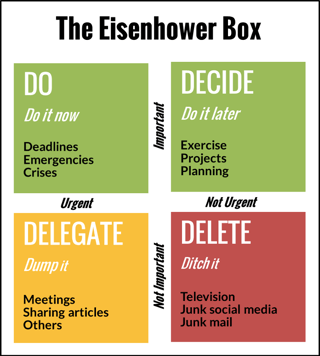 Former U.S. President Dwight D. Eisenhower, in a 1954 speech to the Second Assembly of the World Council of Churches, said:
Former U.S. President Dwight D. Eisenhower, in a 1954 speech to the Second Assembly of the World Council of Churches, said:
"I have two kinds of problems: the urgent and the important. The urgent are not important, and the important are never urgent."
From this, we get the so called "Eisenhower Principle," an idea about the optimal way to view and prioritize your workload. Let’s not forget that before becoming president, Eisenhower rose through the ranks of the United States Army, serving as a five-star general and the Supreme Commander of the Allied Forces during World War II. And of course as POTUS, former President Eisenhower was by all standards, a very productive leader. Now, these principles can help anyone wade through the day and structure it in such a way as to get more of their critical work done. But no one needs this kind of balancing of important and urgent as much as leaders do.
So what is the idea of important and urgent? First let’s look at important versus urgent and what they mean in this context. Important activities generally lead to outcomes that drive us forward in achieving our goals, be they professional or personal. While some important tasks are also urgent, this isn’t typically the case. The important activities tend to be more long range and because the rewards or consequences of doing/not doing them are down the road, many of us put them off in order to focus on what we perceive as urgent. Urgent activities require immediate attention, and are more often related to achieving someone else's objectives. That urgency often puts us in a reactive mode. Urgent activities are frequently the ones we focus on because they demand our attention and the consequences of ignoring them are felt immediately.
What is so often is the biggest source of tension and pressure in the lives of leaders? It is the time demands placed on us. Think about the personal and professional goals you balance on any given day. Then think about how often you find yourself wishing you had just a few more hours in the day to contribute to them. So how can these ideas of urgent and important help you balance your workload and prioritize better? It isn’t completely revolutionary, but consider the Eisenhower “box” as a way to visualize urgent versus important, especially if you are in a high pressure, high demand leadership position.

There are, of course, tasks that are urgent AND important and these items you will do immediately. There are also activities that are important, but not urgent. These you schedule to do later. But you must really make room for these in order to move forward on YOUR most important goals and objectives. Then we have those items that are urgent, but not important. As a leader, these activities are best delegated to someone else. Finally, you have those activities that are neither urgent nor important and the goal here is to remove as many of these unnecessary distractions as possible.
Ideally, you should put the most resources into the Important, but not Urgent quadrant. These items may not have a pressing deadline but are nonetheless important. They are the activities that you believe are most likely to help you find happiness, contentment and success. This also means that as a leader, you may have to give up and delegate tasks that you while you enjoy, are not critical so that you can focus on long range planning and the things you simply cannot delegate to someone else. And if you aren’t certain what should go in your Important But Not Urgent quadrant, you might need to spend some time considering what is really important to you and ultimately, what you want your life to look like. If you don’t, it is all too easy to get bogged down with Urgent and never get to your Important.
As leaders, we all struggle to balance and prioritize our workloads, delegate and make time for long term professional and personal goals. The Eisenhower Square, while not a cure all for the stress and pressure of leadership, is another way to look at what you are doing and adjust to get you closer to your vision for your life.



Leave a Reply